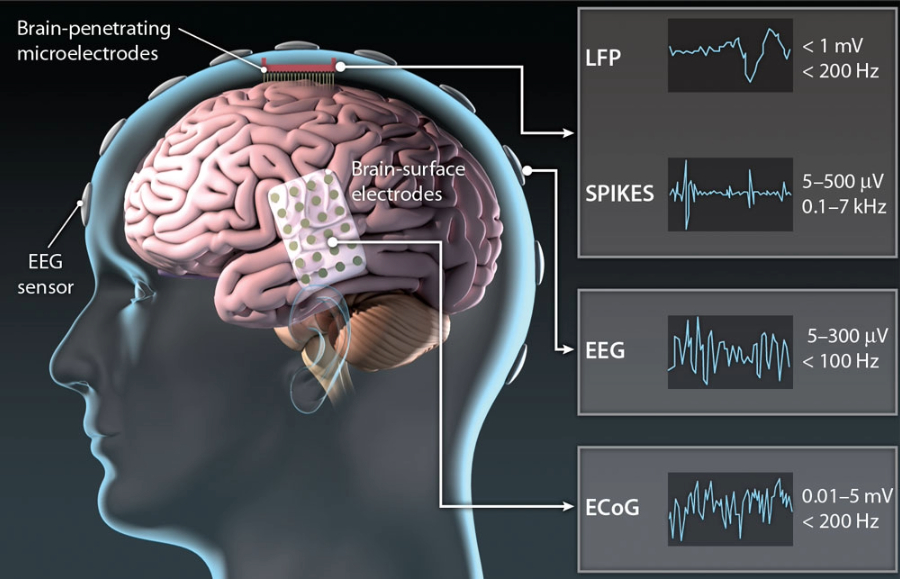Brain-Machine Interface Technologies: Bridging Minds and Machines
Brain-machine interface (BMI) technologies represent a cutting-edge field at the intersection of neuroscience and engineering, aiming to establish a direct communication link between the human brain and external devices. This innovative approach holds immense promise for medical breakthroughs, cognitive enhancements, and revolutionizing human-computer interaction. This article explores the origin, benefits, challenges, and applications, and concludes the evolving landscape of BMI technologies.
Milestones and breakthroughs
- Early Neural Recording Techniques:
– In the mid-20th century, researchers began exploring ways to record and interpret neural signals. Early experiments involved inserting electrodes into the brains of animals to measure and understand the electrical activity of neurons. This laid the foundation for the development of neural recording techniques.
- Emergence of Electrophysiological Methods:
– Electrophysiological methods, such as electroencephalography (EEG) and electrocorticography (ECoG), became prominent in studying neural activity in humans. EEG, which measures electrical activity on the scalp, provides non-invasive insights into brain function. ECoG, involving electrodes placed directly on the brain’s surface, offered higher spatial resolution.
- Invasive Brain Recordings:
– Advancements in microelectronics led to the development of microelectrode arrays, allowing researchers to record neural activity at a more granular level. Invasive methods, such as penetrating electrodes implanted into the brain tissue, became instrumental in decoding specific neural patterns.
- Neuroprosthetics and Brain-Controlled Devices:
– The integration of neural recordings with external devices gained momentum in the development of neuroprosthetics. The first successful brain-controlled devices, including simple prosthetic limbs and computer cursors, showcased the potential of connecting the brain directly to machines.
- Advancements in Signal Processing and Machine Learning:
– The increasing sophistication of signal processing algorithms and machine learning techniques played a crucial role in decoding complex neural patterns. These algorithms translated recorded neural signals into meaningful commands for external devices.
- Neurostimulation Technologies:
– Alongside neural recording, advancements in neurostimulation technologies, such as deep brain stimulation (DBS) and transcranial magnetic stimulation (TMS), allowed researchers to modulate neural activity for therapeutic purposes. This aspect became crucial in medical applications of BMI technology.
- Non-Invasive Approaches:
– Non-invasive BMI methods, particularly EEG-based systems, gained popularity due to their ease of use and lower risk. These systems allowed individuals to control devices using brain signals without the need for invasive surgery.
- Emergence of Brain-Computer Interface Companies:
– The early 21st century saw the establishment of companies dedicated to advancing BMI technology. Notable among them is Neuralink, founded by Elon Musk in 2016, which focuses on developing high-bandwidth interfaces between the human brain and computers.
Applications of Brain-Machine Interface Technologies
- Medical Treatments:
– BMI technologies hold promise for treating a variety of neurological disorders and injuries. They enable individuals with paralysis or spinal cord injuries to regain mobility and independence by controlling prosthetic limbs or exoskeletons with their thoughts. BMIs also offer potential treatments for epilepsy, Parkinson’s disease, and chronic pain through targeted neurostimulation.
- Assistive Devices:
– BMIs play a crucial role in developing assistive technologies for individuals with disabilities. Brain-controlled prosthetics, wheelchairs, and communication devices empower users to interact with their environment and lead more independent lives. BMI systems enable individuals with severe motor impairments to communicate, manipulate objects, and navigate their surroundings using only their thoughts.
- Cognitive Enhancements:
– BMI research explores the potential for enhancing cognitive abilities using brain-computer interfaces. By decoding neural signals associated with memory, attention, and learning, BMI systems aim to augment cognitive function in healthy individuals and those with neurological deficits. While still in the early stages, cognitive enhancement through BMI holds promise for improving cognitive performance and quality of life.
- Human-Machine Integration:
– BMI technology revolutionizes human-machine interaction by enabling direct communication between the brain and external devices. Brain-controlled interfaces facilitate intuitive control of computers, virtual reality systems, and robotic devices. These interfaces enhance user experience, productivity, and accessibility across various domains, from gaming and entertainment to medical simulation and industrial automation.
Challenges and Considerations
1. Privacy and Security:
– Protecting sensitive neural data and ensuring the security of BMI systems against unauthorized access are critical considerations in the development and deployment of these technologies.
- Ethical Implications:
– Ethical considerations surrounding consent, autonomy, and the responsible use of BMI technologies are paramount. Safeguarding individual rights and ensuring equitable access to BMI applications are essential ethical principles.
- Technical Limitations:
– Technical challenges, such as signal degradation, noise interference, and limited signal resolution, pose obstacles to the effectiveness and reliability of BMI systems. Ongoing research aims to address these limitations and improve the performance of neural recording and decoding algorithms.
- Regulatory Frameworks:
– Establishing clear regulatory frameworks and standards for BMI technologies is crucial to ensure safety, efficacy, and ethical use. Regulatory agencies play a vital role in evaluating BMI devices and guiding their responsible integration into healthcare and assistive technology systems.
Role in Neurotechnology
- Neuroscience Research:
– BMI technology provides neuroscientists with powerful tools to study the brain’s function and structure. By recording and decoding neural activity, researchers can investigate fundamental questions about perception, cognition, and behavior. BMI systems enable real-time monitoring of brain activity, offering insights into neural networks’ dynamics and plasticity.
- Brain Mapping and Neurofeedback:
– BMI systems contribute to mapping brain function and connectivity, aiding in the identification of neural circuits underlying specific behaviors and cognitive processes. Neurofeedback techniques, enabled by BMI technology, allow individuals to observe and modulate their brain activity in real time. This approach has applications in neurorehabilitation, stress management, and performance optimization.
Brain-machine interface technologies stand at the forefront of scientific innovation, offering a bridge between the human mind and external devices. While the potential benefits are vast, the complexity of neural interactions demands careful consideration of ethical, legal, and societal implications. As research advances, the responsible development and deployment of BMI technologies will be essential to harness their transformative potential while ensuring the well-being and autonomy of individuals interfacing with this cutting-edge technology.
Source
- https://www.bitsathy.ac.in/blog/minimally-invasive-brain-surgery-high-precision-quick-recovery/
- https://blogs.perficient.com/2023/09/07/bridging-minds-and-machines-the-promise-of-brain-computer-interfaces-bcis-in-assistive-technology/
- https://www.mayoclinic.org/tests-procedures/minimally-invasive-surgery/about/pac-20384771

